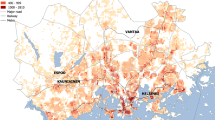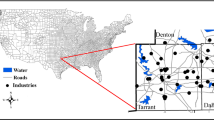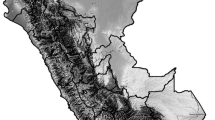Abstract
Air pollution is one of the greatest challenges cities are facing today and improving air quality is a pressing need to reduce negative health impacts. In order to efficiently evaluate which are the most appropriate policies to reduce the impact of urban pollution sources (such as road traffic), it is essential to conduct rigorous population exposure assessments. One of the main limitations associated with those studies is the lack of information about population distribution in the city along the day (population dynamics). The pervasive use of mobile devices in our daily lives opens new opportunities to gather large amounts of anonymized and passively collected geolocation data allowing the analysis of population activity and mobility patterns. This study presents a novel methodology to estimate population dynamics from mobile phone data based on a user-centric mobility model approach. The methodology was tested in the city of Madrid (Spain) to evaluate population exposure to NO2. A comparison with traditional census-based methods shows relevant discrepancies at disaggregated levels and highlights the need to incorporate mobility patterns into population exposure assessments.
This is a preview of subscription content, access via your institution
Access options
Subscribe to this journal
Receive 6 print issues and online access
$259.00 per year
only $43.17 per issue
Buy this article
- Purchase on Springer Link
- Instant access to full article PDF
Prices may be subject to local taxes which are calculated during checkout










Similar content being viewed by others
Notes
The CDR files contain more fields and information. However, only the main fields are shown for simplicity.
Road average speed in the city of Madrid in 2014 was 24 km/h according to city council open database (link). Since distance is measured as a linear trajectory and other modes (bus, metro, walking, etc.) may have lower average speeds, it was considered appropriate to define an average speed of 15 km/h for all kind of trips.
References
World Health Organization. Global Urban Ambient Air Pollution Database [Internet]. WHO; 2016. http://www.who.int/phe/health_topics/outdoorair/databases/cities/en/
European Environmental Agency (EEA). Sources of air pollution in Europe [Internet]. European Environmental Agency (EEA); 2014. https://www.eea.europa.eu/signals/signals-2013/infographics/sources-of-air-pollution-in-europe/view
Curtis L, Rea W, Smith-Willis P, Fenyves E, Pan Y. Adverse health effects of outdoor air pollutants. Environ Int. 2006;32:815–30.
Latza U, Gerdes S, Baur X. Effects of nitrogen dioxide on human health: systematic review of experimental and epidemiological studies conducted between 2002 and 2006. Int J Hyg Environ Health. 2009;212:271–87.
Henneman LR, Liu C, Mulholland JA, Russell AG. Evaluating the effectiveness of air quality regulations: a review of accountability studies and frameworks. J Air Waste Manag Assoc. 2017;67:144–72.
Baxter LK, Dionisio KL, Burke J, Sarnat SE, Sarnat JA, Hodas N, et al. Exposure prediction approaches used in air pollution epidemiology studies: key findings and future recommendations. J Expo Sci Environ Epidemiol. 2013;23:654–9.
Jerrett M, Arain A, Kanaroglou P, Beckerman B, Potoglou D, Sahsuvaroglu T, et al. A review and evaluation of intraurban air pollution exposure models. J Expo Sci Environ Epidemiol. 2005;15:185–204.
Dionisio KL, Isakov V, Baxter LK, Sarnat JA, Sarnat SE, Burke J, et al. Development and evaluation of alternative approaches for exposure assessment of multiple air pollutants in Atlanta, Georgia. J Expo Sci Environ Epidemiol. 2013;23:581–92.
Bekhor S, Broday DM. Data-driven nonlinear optimisation of a simple air pollution dispersion model generating high resolution spatiotemporal exposure. Atmos Environ. 2013;79:261–70.
Korek M, Johansson C, Svensson N, Lind T, Beelen R, Hoek G et al. Can dispersion modeling of air pollution be improved by land-use regression? An example from Stockholm, Sweden. J Exposure Sci Environ Epidemiol. 2017;27:575.
Castell N, Dauge FR, Schneider P, Vogt M, Lerner U, Fishbain B, et al. Can commercial low-cost sensor platforms contribute to air quality monitoring and exposure estimates? Environ Int. 2017;99:293–302.
Mead MI, Popoola OA, Stewart GB, Landshoff P, Calleja M, Hayes M, et al. The use of electrochemical sensors for monitoring urban air quality in low-cost, high-density networks. Atmos Environ. 2013;70:186–203.
Van den Bossche J, Peters J, Verwaeren J, Botteldooren D, Theunis J, De Baets B. Mobile monitoring for mapping spatial variation in urban air quality: development and validation of a methodology based on an extensive dataset. Atmos Environ. 2015;105:148–61.
Solazzo E, Bianconi R, Vautard R, Appel KW, Moran MD, Hogrefe C, et al. Model evaluation and ensemble modelling of surface-level ozone in Europe and North America in the context of AQMEII. Atmos Environ. 2012;53:60–74.
Ching JK. A perspective on urban canopy layer modeling for weather, climate and air quality applications. Urban Clim. 2013;3:13–39.
Baklanov A, Schlünzen K, Suppan P, Baldasano J, Brunner D, Aksoyoglu S, et al. Online coupled regional meteorology chemistry models in Europe: current status and prospects. Atmos Chem Phys. 2014;14:317–98.
de la Paz D, Borge R, Martilli A. Assessment of a high resolution annual WRF-BEP/CMAQ simulation for the urban area of Madrid (Spain). Atmos Environ. 2016;144:282–96.
Santiago JL, Borge R, Martin F, de la Paz D, Martilli A, Lumbreras J, et al. Evaluation of a CFD-based approach to estimate pollutant distribution within a real urban canopy by means of passive samplers. Sci Total Environ. 2017;576:46–58.
Huynh M, Woodruff TJ, Parker JD, Schoendorf KC. Relationships between air pollution and preterm birth in California. Paediatr Perinat Epidemiol. 2006;20:454–61.
Hoek G, Beelen R, De Hoogh K, Vienneau D, Gulliver J, Fischer P, et al. A review of land-use regression models to assess spatial variation of outdoor air pollution. Atmos Environ. 2008;42:7561–78.
Anenberg SC, Horowitz LW, Tong DQ, West JJ. An estimate of the global burden of anthropogenic ozone and fine particulate matter on premature human mortality using atmospheric modeling. Environ Health Perspect. 2010;118:1189.
Boldo E, Linares C, Lumbreras J, Borge R, Narros A, García-Pérez J, et al. Health impact assessment of a reduction in ambient PM 2.5 levels in Spain. Environ Int. 2011;37:342–8.
Cesaroni G, Badaloni C, Gariazzo C, Stafoggia M, Sozzi R, Davoli M, et al. Long-term exposure to urban air pollution and mortality in a cohort of more than a million adults in Rome. Environ Health Perspect. 2013;121:324.
Brunekreef B, Beelen RM, Hoek G, Schouten LJ, Bausch-Goldbohm S, Fischer P, et al. Effects of long-term exposure to traffic-related air pollution on respiratory and cardiovascular mortality in the Netherlands: the NLCS-AIR study. Res Rep Health Eff Inst. 2009;139:5–71.
Künzli N, Kaiser R, Medina S, Studnicka M, Chanel O, Filliger P, et al. Public-health impact of outdoor and traffic-related air pollution: a European assessment. Lancet. 2000;356:795–801.
Pope CA III, Dockery DW. Health effects of fine particulate air pollution: lines that connect. J air & Waste Manag Assoc. 2006;56:709–42.
Avery CL, Mills KT, Williams R, McGraw KA, Poole C, Smith RL, et al. Estimating error in using ambient PM2. 5 concentrations as proxies for personal exposures. Epidemiology (Cambridge, MA). 2010;21:215.
Setton E, Marshall JD, Brauer M, Lundquist KR, Hystad P, Keller P, et al. The impact of daily mobility on exposure to traffic-related air pollution and health effect estimates. J Expo Sci Environ Epidemiol. 2011;21:42–8.
Shekarrizfard M, Faghih-Imani A, Tetreault LF, Yasmin S, Reynaud F, Morency P, et al. Modelling the spatio-temporal distribution of ambient nitrogen dioxide and investigating the effects of public transit policies on population exposure. Environ Model Softw. 2017;91:186–98.
Beckx C, Panis LI, Arentze T, Janssens D, Torfs R, Broekx S, et al. A dynamic activity-based population modelling approach to evaluate exposure to air pollution: methods and application to a Dutch urban area. Environ Impact Assess Rev. 2009;29:179–85.
Dons E, Panis LI, Van Poppel M, Theunis J, Willems H, Torfs R, et al. Impact of time–activity patterns on personal exposure to black carbon. Atmos Environ. 2011;45:3594–602.
Lefebvre W, Degrawe B, Beckx C, Vanhulsel M, Kochan B, Bellemans T, et al. Presentation and evaluation of an integrated model chain to respond to traffic-and health-related policy questions. Environ Model & Softw. 2013;40:160–70.
Ragettli MS, Phuleria HC, Tsai MY, Schindler C, De Nazelle A, Ducret-Stich RE, et al. The relevance of commuter and work/school exposure in an epidemiological study on traffic-related air pollution. J Expo Sci Environ Epidemiol. 2015;25:474–81.
Burke JM, Zufall MJ, Özkaynak H. A population exposure model for particulate matter: case study results for PM2. 5 in Philadelphia, PA. J Expo Sci Environ Epidemiol. 2001;11:470.
Hatzopoulou M, Miller EJ. Linking an activity-based travel demand model with traffic emission and dispersion models: transport’s contribution to air pollution in Toronto. Transp Res Part D: Transp Environ. 2010;15:315–25.
Panis LI. New Directions: air pollution epidemiology can benefit from activity-based models. Atmos Environ. 2010;44:1003–4.
Borge R, Narros A, Artíñano B, Yagüe C, Gómez-Moreno FJ, de la Paz D, et al. Assessment of microscale spatio-temporal variation of air pollution at an urban hotspot in Madrid (Spain) through an extensive field campaign. Atmos Environ. 2016;140:432–45.
Fellendorf M, Vortisch P. Microscopic traffic flow simulator VISSIM. Fundamentals of traffic simulation. New York: Springer; 2010. p. 63–93.
Zheng Y, Li Q, Chen Y, Xie X, Ma WY. Understanding mobility based on GPS data. In: Proceedings of the 10th international conference on Ubiquitous computing. ACM; 2008. p. 312–21.
Zignani M, Gaito S. Extracting human mobility patterns from gps-based traces. In: Wireless Days (WD), IFIP 2010. IEEE; 2010. p. 1–5.
Hasan S, Zhan X, Ukkusuri SV Understanding urban human activity and mobility patterns using large-scale location-based data from online social media. In: Proceedings of the 2nd ACM SIGKDD international workshop on urban computing; 2013. ACM. p. 6.
Glasgow ML, Rudra CB, Yoo EH, Demirbas M, Merriman J, Nayak P, et al. Using smartphones to collect time–activity data for long-term personal-level air pollution exposure assessment. J Expo Sci Environ Epidemiol. 2016;26:356–64.
Van Londersele B, Delafontaine M, Van de Weghe N. Bluetooth tracking. GIM Int. 2009;23:23–5.
Versichele M, Neutens T, Delafontaine M, Van, de Weghe N. The use of Bluetooth for analysing spatiotemporal dynamics of human movement at mass events: a case study of the Ghent Festivities. Appl Geogr. 2012;32:208–20.
Naini FM, Dousse O, Thiran P, Vetterli M. Population size estimation using a few individuals as agents. In: 2011 IEEE international symposium on Information theory proceedings (ISIT), 2011. IEEE. p. 2499–503.
Kontokosta CE, Johnson N. Urban phenology: toward a real-time census of the city using Wi-Fi data. Comput Environ Urban Syst. 2017;64:144–53.
Kotaru M, Joshi K, Bharadia D, Katti S. Spotfi: decimeter level localization using wifi. In: SIGCOMM Computer Communication Review 2015, Vol. 45, No. 4. New York, NY: ACM. 2015. p. 269–82.
Rhee I, Shin M, Hong S, Lee K, Kim SJ, Chong S. On the levy-walk nature of human mobility. IEEE/ACM Trans Netw (TON). 2011;19:630–43.
Picornell M, Ruiz T, Lenormand M, Ramasco JJ, Dubernet T, Frías-Martínez E. Exploring the potential of phone call data to characterize the relationship between social network and travel behavior. Transportation. 2015;42:647–68.
Calabrese F, Diao M, Di Lorenzo G, Ferreira J Jr, Ratti C. Understanding individual mobility patterns from urban sensing data: a mobile phone trace example. Transp Res Part C: Emerg Technol. 2013;26:301–13.
Ratti C, Frenchman D, Pulselli RM, Williams S. Mobile landscapes: using location data from cell phones for urban analysis. Environ Plan B: Plan Des. 2006;33:727–48.
Reades J, Calabrese F, Sevtsuk A, Ratti C. Cellular census: explorations in urban data collection. IEEE Pervasive computing. Vol. 6, No. 3; 2007.
Terada M, Nagata T, Kobayashi M. Population estimation technology for mobile spatial statistics. NTT DOCOMO Techn J. 2013;14:10–5.
Deville P, Linard C, Martin S, Gilbert M, Stevens FR, Gaughan AE, et al. Dynamic population mapping using mobile phone data. Proc Natl Acad Sci. 2014;111:15888–93.
Dewulf B, Neutens T, Lefebvre W, Seynaeve G, Vanpoucke C, Beckx C, et al. Dynamic assessment of exposure to air pollution using mobile phone data. Int J Health Geogr. 2016;15:14.
Nyhan M, Grauwin S, Britter R, Misstear B, McNabola A, Laden F, et al. “Exposure Track” the impact of mobile-device-based mobility patterns on quantifying population exposure to air pollution. Environ Sci Technol. 2016;50:9671–81.
Gariazzo C, Pelliccioni A, Bolignano A. A dynamic urban air pollution population exposure assessment study using model and population density data derived by mobile phone traffic. Atmos Environ. 2016;131:289–300.
Isaacman S, Becker R, Cáceres R, Kobourov S, Martonosi M, Rowland J, et al. Identifying important places in people’s lives from cellular network data. In: International conference on pervasive computing. Berlin, Heidelberg: Springer; 2011. p. 133–51.
Phithakkitnukoon S, Smoreda Z, Olivier P. Socio-geography of human mobility: A study using longitudinal mobile phone data. PLoS ONE. 2012;7:e39253.
Chen C, Mei Y, Liu Y Does distance still matter in facilitating social ties? The roles of mobility patterns and the built environment. In: Transportation Research Board 93rd Annual Meeting; 2014 (No. 14-4787).
Skamarock WC, Klemp JB. A time-split nonhydrostatic atmospheric model for weather research and forecasting applications. J Comput Phys. 2008;227:3465–85.
Institute for the Environment. SMOKE v2.7 user’s manual. Chapel Hill, NC: University of North Carolina [Internet]. Institute for the Environment; 2009. https://www.cmascenter.org/smoke/
Byun D, Schere KL. Review of the governing equations, computational algorithms, and other components of the Models-3 Community Multiscale Air Quality (CMAQ) modeling system. Appl Mech Rev. 2006;59:51–77.
Borge R, Lumbreras J, Pérez J, de la Paz D, Vedrenne M, de Andrés JM, et al. Emission inventories and modeling requirements for the development of air quality plans. Application to Madrid (Spain). Sci Total Environ. 2014;466:809–19.
Borge R, de Miguel I, de la Paz D, Lumbreras J, Pérez J, Rodríguez M. Comparison of road traffic emission models in Madrid (Spain). Atmos Environ. 2012;62:461–71.
Borge, R, Santiago, JL, de la Paz, D, Martín, F, Domingo, J, Valdés, C, et al. Application of a short term air quality action plan in Madrid (Spain) under a high-pollution episode—Part II: Assessment from multi-scale modelling. Science of the Total Environment; 2018. https://doi.org/10.1016/j.scitotenv.2018.04.323
Yu H, Russell A, Mulholland J, Huang Z. Using cell phone location to assess misclassification errors in air pollution exposure estimation. Environ Pollut. 2018;233:261–6. https://doi.org/10.1016/j.envpol.2017.10.07
Yoo E, Rudra C, Glasgow M, Mu L. Geospatial estimation of individual exposure to air pollutants: moving from static monitoring to activity-based dynamic exposure assessment. exposure assessment, Ann Assoc Am Geographers. 105:915–26. https://doi.org/10.1080/00045608.2015.1054253
Acknowledgements
This study was supported by the Madrid City Council and the TECNAIRE-CM (innovative technologies for the assessment and improvement of urban air quality) scientific program funded by the Directorate General for Universities and Research of the Greater Madrid Region (S2013/MAE-2972)
Author information
Authors and Affiliations
Corresponding author
Ethics declarations
Conflict of interest
The authors declare that they have no conflict of interest.
Rights and permissions
About this article
Cite this article
Picornell, M., Ruiz, T., Borge, R. et al. Population dynamics based on mobile phone data to improve air pollution exposure assessments. J Expo Sci Environ Epidemiol 29, 278–291 (2019). https://doi.org/10.1038/s41370-018-0058-5
Received:
Revised:
Accepted:
Published:
Issue Date:
DOI: https://doi.org/10.1038/s41370-018-0058-5
Keywords:
This article is cited by
-
Long-term exposure and health risk assessment from air pollution: impact of regional scale mobility
International Journal of Health Geographics (2023)
-
Ultra-high-resolution mapping of ambient fine particulate matter to estimate human exposure in Beijing
Communications Earth & Environment (2023)
-
Assessing air pollution exposure misclassification using high-resolution PM2.5 concentration model and human mobility data
Air Quality, Atmosphere & Health (2023)
-
Measuring objective and subjective well-being: dimensions and data sources
International Journal of Data Science and Analytics (2021)
-
Influence of environmental drivers on allergy to pollen grains in a case study in Spain (Madrid): meteorological factors, pollutants, and airborne concentration of aeroallergens
Environmental Science and Pollution Research (2021)



